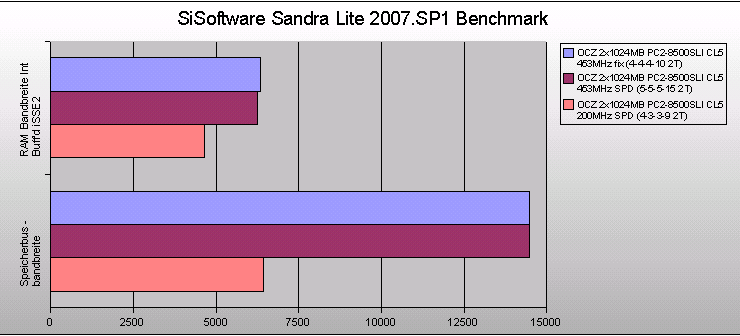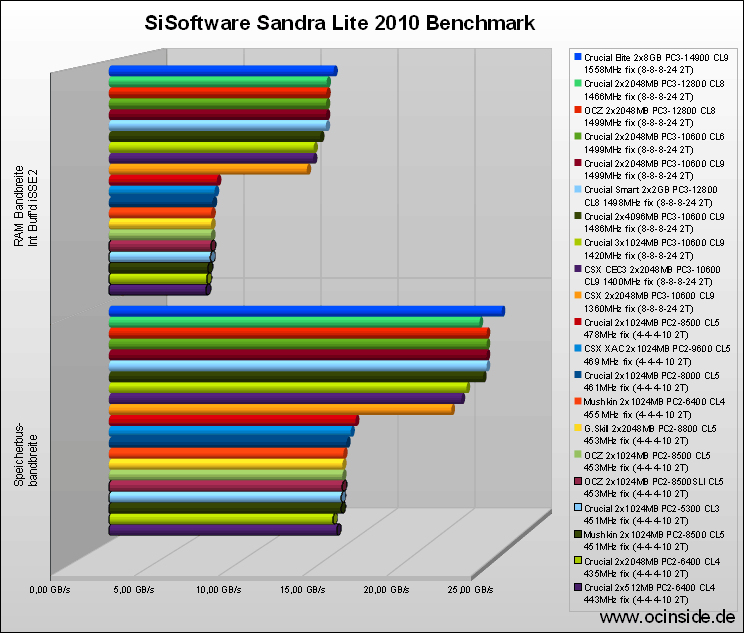
Let us begin with the most important part of the test report, because the optics and packing is of course rather secondary and the highest possible stable performance is the most important factor. CPU on different frequencies depending on the reference clock for the different memory benchmarks. Furthermore the memory modules were tested on another reference board to test the high frequency and higher voltages. The Foxconn C51XEM2AA motherboard comes with the nVidia nForce 590 SLI chipset and supports the EPP feature to realize an automatically adjustment of the memory timings. The multiplier adjustment remains on 9x with all frequencies, because an adjustment for the CPU in half multiplier steps would be too inaccurate to get nearly the same CPU frequency for all tests.
Microsoft Windows XP Professional SP2 is used as the operating system. The stability was examined with the software Memtest86
and SiSoft Sandra Lite 2007.SP1 program is used for all benchmarks, since it offers extensive adjustments and a fast result comparison. BTW. the latest SiSoft Sandra 2008 version is available on our download server and can be downloaded much faster – ALL benchmarks are also included in the free Lite version.
But let us continue with the review … First the maximum possible frequency of the memory module was determined. The memory frequency was increased in small steps with a fixed memory timing of 4-4-4-10 2T and default memory voltage, as long as the detailed memory test with Memtest86 runs without any errors. This quite long testing time ensured that this frequency works really stable with these modules.
The highest possible frequency with 4-4-4-10 (Tcl Trcd Tras Trp) timings was stable with high 453 MHz !
Of course it’s possible to run much higher frequencies with increased voltages or lower timings, because the frequency values and timings depends directly from each other. Officially OCZ specify the voltage of 2.30 Volt without loosing the warranty. The OCZ EVP (Extended Voltage Protection) technology allows a maximum voltage of 2.45 Volt and this is a considerable voltage also for ambitious overclocker. It was no problem to overclock these modules with 2.30 Volt (instead of 1.80V) higher than 1066 MHz (533 MHz x2 CL5). But this isn’t possible on all motherboards, because these high clock rates are not supported on all motherboards and on a lower memory voltage (Vmem) it’s not possible to achieve these nice results.
The slightly modified Foxconn C51XEM2AA reference board supports up to 2.50 Volt Vmem, which results in a very fast frequency of more than 600 MHz (DDR2-1200). Nevertheless all memory overclocking comparisons are done with default 1.80 Volt and this was enough to reach 453 MHz.
This highest possible frequency was compared with two settings. On the one hand 453 MHz with SPD values (these are programmed in the SPD IC by the manufacturer), and on the other hand 200 MHz (x2) with SPD values.
By the way, the “Memory Bus Range” is no benchmark value, but this value is quite simple to calculate by the frequency and is useful for the benchmark comparison.
Here’re the benchmark results:
| Frequency | Timing | RAM Range Int Buff’d iSSE2 | Memory bus range |
| 453 MHz | fix (4-4-4-10 2T) | 6338 MB/s | 14496 MB/s |
| 453 MHz | SPD (5-5-5-15 2T) | 6267 MB/s | 14496 MB/s |
| 200 MHz | SPD (4-3-3-8 2T) | 4651 MB/s | 6432 MB/s |
Here’s a diagram of the benchmark values:

Here is a direct benchmark result comparison of some DDR2 and DDR memory modules:

With a default voltage of 1.80 V the PC2-8500 kit already reaches a quite good result, but for a high overclocking result it is – like so often – necessary to rise the memory voltage. With 2.30 Volt or more the can be overclocked easily over 1066 MHz and thanks to the EPP support OCZ offers for these high overclocking values an official permission – tuning desired!

